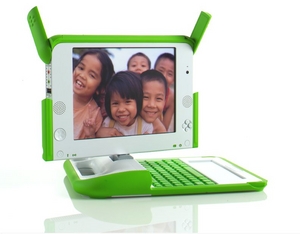The OLPC Wiki: Difference between revisions
mNo edit summary |
|||
| Line 18: | Line 18: | ||
This is the wiki for the One Laptop per Child association. The mission of this non-profit association is to develop a low-cost laptop—the "$100 Laptop"—a technology that could revolutionize how we educate the world's children. Our goal is to provide children around the world with new opportunities to explore, experiment, and express themselves. |
This is the wiki for the One Laptop per Child association. The mission of this non-profit association is to develop a low-cost laptop—the "$100 Laptop"—a technology that could revolutionize how we educate the world's children. Our goal is to provide children around the world with new opportunities to explore, experiment, and express themselves. |
||
Why do children in developing nations need laptops? Laptops are both a window and a tool: a window into the world and a tool with which to think. They are a wonderful way for all children to learn learning through independent interaction and exploration. |
Why do children in developing nations need laptops? Laptops are both a window and a tool: a window into the world and a tool with which to think. They are a wonderful way for all children to learn learning through independent interaction and exploration. [[The Children's Machine|More]] |
||
==What you'll find inside== |
==What you'll find inside== |
||
Revision as of 13:10, 17 August 2006
What's new
We have reached an important milestone: the dual-mode display works in prototype! We have been counting on Mary Lou Jepsen's new approach to LCD displays to help us achieve our price and power consumption targets and enable our expected models of indoor and outdoor use, while also rapidly achieving mass production. We now have a display that can readily be mass produced in standard LCD factories, with no process changes. Our display has higher resolution than 95% of the laptop displays on the market today; approximately 1/7th the power consumption; 1/3rd the price; sunlight readability; and room-light readability with the backlight off.
OLPC in the news can be found in Current events. Weekly updates can be found here.
About One Laptop per Child
- It's an education project, not a laptop project.
This is the wiki for the One Laptop per Child association. The mission of this non-profit association is to develop a low-cost laptop—the "$100 Laptop"—a technology that could revolutionize how we educate the world's children. Our goal is to provide children around the world with new opportunities to explore, experiment, and express themselves.
Why do children in developing nations need laptops? Laptops are both a window and a tool: a window into the world and a tool with which to think. They are a wonderful way for all children to learn learning through independent interaction and exploration. More
What you'll find inside
A good place to start exploring this wiki is the One Laptop per Child page, which gives an overview of the project. There is a list of frequently asked questions (FAQ); a place to ask a question; and numerous pages on hardware, software, content, and the developer program—and a separate wiki for software development. There are also discussion pages on issues of deployment and country-specific discussions. An extended table of contents is also available.
About this Wiki
The purpose of this wiki is to both share information about the project and to solicit ideas and feedback. The articles and discussion vary from technical to epistemological. We invite comments on every page (please use the "discussion" tab at the top of each page). Please restrict edits to the article pages themselves to facts, not opinions. You are encouraged to sign your work and to make liberal use of citations and links. (Please feel free to make an account and please use ~~~~ as a signature for your comments.) Please note that pages that include the {{OLPC}} template—such as this one—are maintained by the OLPC team and are generally representative of the current state of the project. Other pages—created and maintained by the public—should be read with that in mind.
